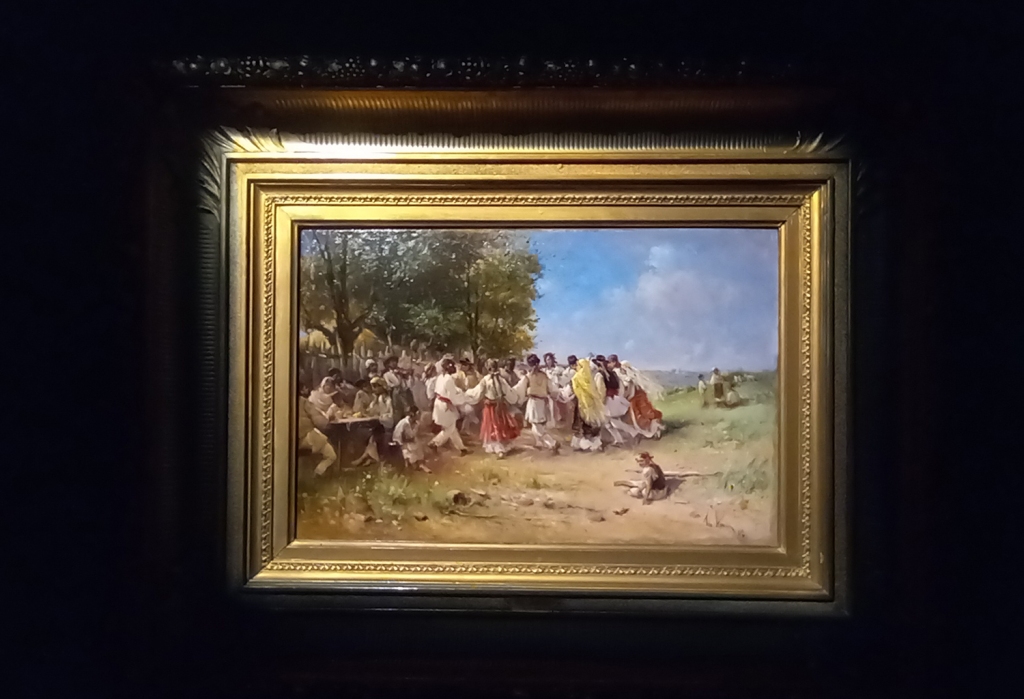
I’m getting ready to go to this year’s second edition of Art Safari here in Bucharest, but for now I thought I’d post some highlights from this spring, starting—for this installment—with some works of Theodor Aman and his biography, which were showcased at the fair.
Aman was the first Romanian modern painter and, by the looks of it, much more accomplished—and modern—than I’d appreciated before. I’ve visited his museum in central Bucharest (close to the National Art Museum), but it looks like most of his better works have taken flight elsewhere, to other museums and collectors in Bucharest and the rest of the country. This show, curated by Elena Olariu, was marvelous: great pieces and wonderful information panels in the exhibition halls.
Theodor Aman’s life begins in 1831. He is the son of Dimitrie, a wealthy merchant of Aromanian origins, and Despina, a music and literature enthusiast of Greek lineage. Upon Dimitrie’s death in 1834, Despina becomes Theodor’s sole parent. She will make sure that her son gets a good education. He studies in Craiova and then, for high school, at the best college in Bucharest, Sfântul Sava.
In 1850 Aman leaves for Paris, where he will remain for the next seven years. He studies with two disciples of Jacques-Louis David (1748–1825), the great Neoclassical painter. In Paris, at the Bibliothèque nationale, Aman copies portraits of Romanian rulers and studies Turkish costumes from the time of Michael the Brave (Mihai Viteazul) in preparation for his 1852 work The Last Night of Michael the Brave. In 1852, at 22, he exhibits a self-portrait (now lost) at the French Salon. It’s his first painting juried into the Salon. He paints two more historical paintings, in 1854 and 1855, respectively, and continues to show other works at the French Salon. In 1857 he paints the allegory The Union of the Principalities, a reflection of his wish to see Wallachia and Moldavia become one country, which will come to pass in 1859.
He travels to Rome, Venice, and Milan, and in 1858 returns for good to what in 1862 officially becomes Romania. He starts painting commissioned portraits along with paintings for the state.
In 1864 Theodor Aman and Gheorghe Tattarescu establish a School of Fine Arts in Bucharest, the second such institution of superior education in Southeast Europe, subsequent to one in Greece. A second such School of Fine Arts is set up in Iasi by G. Panaitescu-Bardasare, who took inspiration and guidance from Aman.
Aman becomes director and painting professor at the School of Fine Arts he has cofounded in Bucharest.
He marries in 1965. His wife, Ana, had been married before and had three children. They will not have children together. Aman organizes the first edition of an exhibition with works by living artists. He participates with twenty-four paintings and other art pieces.
In 1867–68 he starts work on a house of his own design, with exterior decoration by sculptor Karl Storck. The house will be finished in 1869. Aman will design the furniture as well. This house will become a magnet for figures of the local elite, including, on certain occasions, future queen Elisabeta.
On a personal note, when I last visited the museum sometime in the 2010s I noticed Aman’s cello. He was a talented cellist, and he often played at his soirées. Now that I think about it, I may have seen a piano at the house as well. His stepdaughter Zoe played the piano and they often performed together at Aman’s home.
Exhibited at Aman’s memorial house are also a number of prints. Aman starts learning printmaking in 1872 and by his death in 1891 he has become quite accomplished in this medium as well.
In his last decade of life Theodor Aman has three large retrospective exhibitions. He also receives various state honors during his lifetime as a token of the appreciation lavished on him in his country.
In 1904 Ana Aman donates their former home—which was also Aman’s atelier—to the Romanian state, together with all the works in it. Aman House opens its doors as a museum in 1908.
(Biography based on the info panels at Art Safari, with an added note regarding Despina’s interest in music and literature.)
Here are some of Theodor Aman’s paintings from the Art Safari exhibition of May 12–August 7, 2022.

Theodor Aman, Doamnă pictând (Lady Painting), 1862

Theodor Aman, Tânără în hamac (Young Woman in a Hammock)

Theodor Aman, still life [no title given]

Theodor Aman, Hora de la Aninoasa (Round Dance at Aninoasa)
